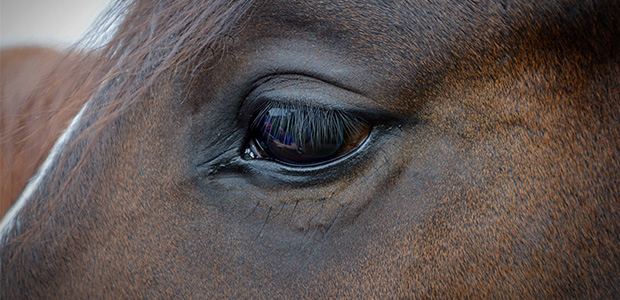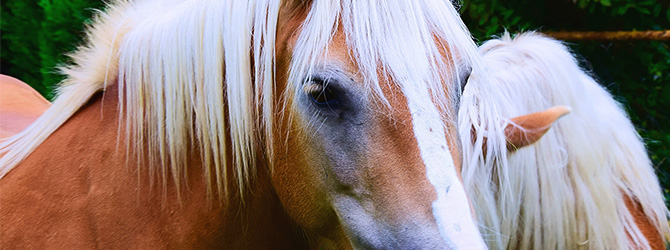Acute eye pain in horses: symptoms, causes and treatments
2 min read
First Published: 28/10/2019
Last Updated: 24/11/2022
Horses’ large, prominent eyes are positioned so that they can see almost 360ᵒ around themselves.
This is great at helping them spot predators, but it can have its flaws.
Their eyes are fragile and prone to injuries and diseases which can, if left unattended, have a devastating impact on their vision.
Signs of eye pain
Every time you visit your horse, look out for:
- Cuts, grazes and abrasions
- A watery eye
- A fully/partially closed eye
- Discharge
- Redness, inflammation or swelling of the eye
- Eyelashes pointing lower than normal
- Sensitivity to light
- Excessive blinking or squinting
- A change to the colour of the cornea
- Rubbing the eye against the inside of the knee or other objects
- One eye a different size to the other
Most issues tend to affect one eye only. Minor injuries and infections can become much more serious if left to ‘heal by themselves’, so it’s important to treat eye problems as an emergency, and to seek veterinary assistance as soon as possible.
Common causes of eye pain
Pain could stem from a fleck of dust trapped in your horse’s eye, or from something far more serious. Common causes include:
- Trauma (to the eyelids, skin, bony sockets or to the eye itself)
- Foreign bodies
- Corneal ulcer
- Inflammation or infection
- Glaucoma (increased pressure inside the eye)
Once your vet has examined your horse, they’ll be able to determine the cause of pain and to prescribe a suitable treatment.

I’ve contacted the vet. What will happen next?
If you do spot an issue, move your horse to a dark stable or barn. This will help with their sensitivity to light, and also to keep them calm. It’s a good idea to restrain your horse so they can’t damage themselves further.
Don’t be tempted to use leftover medication from previous vet visits – you may end up causing more damage.
The vet will need somewhere dark to examine the horse. They may use special drops to dilate the pupils and in some cases, sedation or anaesthetic may be required.
Treating eye pain
Treatments will depend on the underlying cause of your horse’s condition and the severity of their symptoms. Conjunctivitis and corneal ulcers may be treated with eye drops; wounds may need stitches. Certain complex cases may require hospitalisation, or even surgery.
If your horse is reluctant to accept treatment or if they find the ordeal too painful/stressful, the vet may use a special tube to help administer the medication.
Reducing the risks
Try to keep your horse’s home environment safe and clean. Check stables, fences and trailers to make sure there are no:
- Broken items, hooks or nails
- Cracks or gaps (especially in fences)
- Spiky weeds or bushes
If your horse often tries to graze on the other side of the fence, try adding something special to their field to keep them occupied. You could also fill in the gaps between fence struts using electrical tape or rope.
Make sure that your horse is protected from insects. Try insect repellent and a fly mask (fly masks also provide great protection from UV rays) and of course, keep manure to a minimum.
Need more info?
For more help and guidance on eye pain in horses, or any other aspect of your horse’s welfare, have a chat with your local equine vet.
Find your nearest vet using our Find a Vet page, or speak to a vet online using Online Vets.
